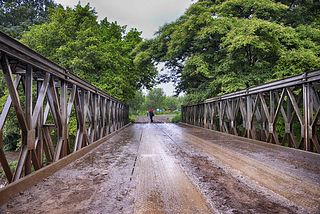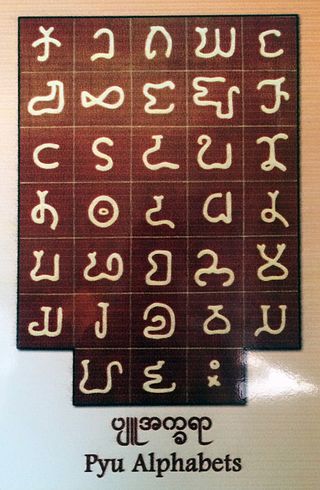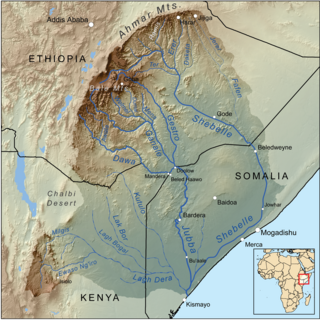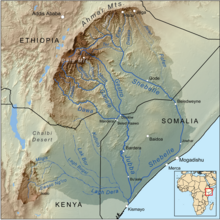The Usno River is a tributary of the Omo River in Ethiopia. Formed by the confluence of the Magi and the Neri rivers, it flows south past the Nyalibong Hills before entering the Omo. Almost all of the Usno's course is inside the boundaries of the Mago National Park.
The Germama River, is a tributary of the Awash River in Ethiopia. The name Germama comes from the Amharic word which means "frolicking", "boisterous", or "frisky".

The Akobo River is a river on the border between South Sudan and Ethiopia. From its source in the Ethiopian Highlands near Mizan Teferi it flows west for 434 kilometres (270 mi) to join the Pibor River. The Pibor flows into the Sobat River, which in turn empties into the White Nile.
Katar River is a river of central Ethiopia. It arises from the glaciated slopes of Mount Kaka and Mount Badda in the Arsi Zone. The Katar's tributaries include the Gonde. The gradient of the river is generally steep, and areas suitable for irrigation are few in number and very limited in extent. With a watershed of 3,398 km2, the Katar drains into Lake Ziway. It is the largest river draining into Lake Ziway.

The Pyu language is an extinct Sino-Tibetan language that was mainly spoken in what is now Myanmar in the first millennium CE. It was the vernacular of the Pyu city-states, which thrived between the second century BCE and the ninth century CE. Its usage declined starting in the late ninth century when the Bamar people of Nanzhao began to overtake the Pyu city-states. The language was still in use, at least in royal inscriptions of the Pagan Kingdom if not in popular vernacular, until the late twelfth century. It became extinct in the thirteenth century, completing the rise of the Burmese language, the language of the Pagan Kingdom, in Upper Burma, the former Pyu realm.

The Mille River is a river of Ethiopia and a tributary of the Awash. It drains parts of the Semien (North) Wollo and Debub (South) Wollo Zones of the Amhara Region, as well as Administrative Zone 4 of the Afar Region. The explorer L.M. Nesbitt, who travelled through the area in 1928, was impressed by its size, and described the Mille as "probably the only real river which joins the Awash". The Ala River (A'ura) and Golima River (Golina) are small tributaries of the Mille.

Alwero River is a river in Abobo woreda of Gambela Region, Ethiopia. It flows through the Gambela National Park and through wetlands into the Openo/Baro River.
Borkana River is a river of central Ethiopia. A left tributary of the Awash. Johann Ludwig Krapf records that it was called "Tshaffa" by the local Oromo people.
The Dembi is a river of southwestern Ethiopia, in the Debub Bench district.

The Erer is a perennial river of eastern Ethiopia. It rises near the city of Harar, in Harari Region, and flows in a primarily southern direction to its confluence with the Shabelle.

Fafen River is a river of eastern Ethiopia. Rising to the east of Harar, in Harari Region, it cuts through a series of wide, flat shelves of sedimentary rocks made of sandstone, limestone, and gypsum as it descends in a south-eastern direction towards the Shebelle River. The Fafen only joins the Shebelle river during times of heavy rainfall.
Galetti River is a river in eastern Ethiopia. It is a tributary of the Ramis River, which is in turn a tributary of the 2,714 km long Shebelle River.
Gololcha River is a river of eastern Ethiopia. It flows into the Awash River.
Hawadi River is a river of Ethiopia. It is a tributary of the Awash River.
The Keleta is a river in Ethiopia. It arises near the Chilalo mountains and flows into the Awash River.
Kibish River is a river of southern Ethiopia, which defines part of that country's border with South Sudan and Kenya. It flows towards Lake Turkana, although some years it does not have enough volume to reach it, as C.W. Gwynn discovered in 1908.
The Meki is a river in central Oromia, Ethiopia. It empties into Hora-Dambal.

The Mena is a river of eastern Ethiopia. It is located in the Delo Menna woreda in Bale Zone, Oromia Region. Its source lies in the Bale Mountains. It is a tributary of the Ganale Dorya.

Weyib River is a river of eastern Ethiopia. It rises in the Bale Mountains east of Goba in the Oromia Region, flowing east to pass through the Sof Omar Caves, then to the southeast until it joins the Ganale Dorya River in the Somali Region.

The Welmel is a river of eastern Ethiopia. It is a tributary of the Ganale Dorya River, which in turn is a tributary of the Jubba River. The headwaters of the Welmel are in the Bale Mountains of the Ethiopian Highlands, and it flow southeast for 311 km (193 mi) to its mouth.






